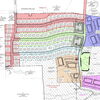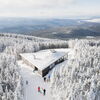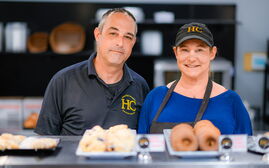
Processing Your Payment
Please do not leave this page until complete. This can take a few moments.
Allen Island: A living lab where students can learn from fishermen, scientists, historians and artists
The Dreadnought speeds through the waters off Port Clyde, cutting a path to Allen Island, where its owner, painter Jamie Wyeth, wants to be sure he reaches the dock to greet the visitors on the boats left in his wake. Perhaps aptly, the first visible sign we see of the mist-shrouded island is the Weymouth Cross, erected in 1907 to commemorate the first Anglican Church service held in the New World 300 years before.
The two other boats reach the dock carrying a group of journalists and professors and students from Colby College, which along with Wyeth family foundation Up East, invited us to the private island on July 13, the day after the centennial celebration of Andrew Wyeth, Jamie's father. Our mission is to explore the learning and conservation that takes place on the island and see some of the Wyeth paintings less frequently shown to the public.
After the 20-minute boat ride, Jamie greets us with a warm smile, salt and pepper hair swept back as he leans into the wind and looks intently at us and alternately at the horizon. He's garbed in black knickers, leggings showing from atop his rubber boots, a white artist's shirt and a beige raincoat to ward off the gusts and rain. His wife Phyllis, on her red scooter with family dog Iggy tucked under her skirt, sits next to him, egging him on to talk about the dream of his mother Betsy Wyeth to turn the 450-acre island into a living learning lab and working waterfront.
He gestures enthusiastically, blue paint on his right hand cuticles, and talks of his boyhood love of the islands in Muscongus Bay, and how the Wyeths came to own Allen Island and neighboring Benner Island, where Betsy lives in the summer.
“I grew up in Cushing, and saw Monhegan from there,” Jamie says. “After my first shows in New York, I moved to Monhegan.” Later he and Phyllis bought Allen Island in 1979, and mother Betsy bought Benner.
Art and science meet on Allen Island
Up East Inc., a Wyeth family foundation established in the 1990s by Betsy, supports environmental and ecological research, preservation and education in mid-coast Maine. On this day, surrounded by Colby students and faculty, Jamie says his mother is proud to see her plan come to fruition.
When Colby and Up East announced their 10-year collaboration last October to allow students and researchers to study on the island, Jamie said, “Since the time my mother, Betsy James Wyeth, formed Up East, it has been her goal to create opportunities for fishermen to interact with marine scientists, for archeologists to interact with historians, and to support the community and residents of the mid-coastal region of Maine. The relationship with Colby promises to do all that and more.”
That includes the new study center. We walk up a narrow stone path, past immaculately sculpted flower gardens to a new building, where Jamie cuts the ribbon and we walk inside to see a display-encased replica of the key buildings on the island: the dock, which also is a working waterfront stacked with lobster traps and houses a weather station to study climate change; the Allen House, a tiny building to house visiting faculty and made of off-white clapboard with a stone front; the Salt Loft art gallery; the barn; the Bunk House, where Colby students and faculty create documentary videos; and a few other buildings. There's just one main unpaved road on the island with some offshoots, plus a series of trails between buildings and key points on the island, like the solar-powered clam-shell fountain and a utility tunnel that keeps electric wires underground.

Jamie leads us up another path to the barn, where steamed lobster, corn on the cob, homemade blueberry pie and other goodies await to renew our energy before we explore the island. Another of the Wyeth dogs, Cody, shamelessly sticks his head into the pail of discarded lobster shells.
Conservation is key
Up East spends most of its funds to maintain the island's infrastructure. In its most recent Form 990-PF tax filing, which runs through Feb. 16, 2016, the Chadds Ford, Pa., foundation's assets totaled $10.2 million, according to GuideStar. Grants and contributions totaled $87,951, including $46,551 to Unity College and $7,500 to the Herring Gut Learning Center in Port Clyde. Andrew Wyeth was the youngest of five children of illustrator N.C. Wyeth, and the family split time between Chadds Ford and Port Clyde.
“We have a significant investment in the island itself,” William Martin, secretary and treasurer of Up East, tells Mainebiz in an interview after the island visit. He adds that Colby started using the island last year. “Colby enthusiastically embraced the use of Allen Island as a laboratory for faculty and students. It's been a real success.”
Philip Conkling, owner of the Camden consultancy Conkling & Associates and a co-founder of the Island Institute, which he led for 30 years, helped advise Betsy to create the foundation. He's a consulting advisor to Up East's board. Jamie represents the Wyeth family at Up East.
Conkling, a graduate of the Yale School of Forestry and Environmental studies, says he met Betsy after she heard he had discovered a stand of 100-year-old yellow birch trees, some up to four feet in diameter, on the southwest end of the island. At the time, he was surveying Maine islands for the Nature Conservancy.
“I was hired by Betsy in 1979 to produce a forest management and pasture-clearing plan for Allen Island, where her husband Andrew painted models of fishermen working the coast,” Conkling says. “In 1979 the islands looked feral with overgrowth and had some squatter fishermen living on them.”
He cleared 500 cords of wood and took them to Port Clyde. On the return trip he brought nature's lawnmowers, sheep, to trim back the grasses. Goats were later introduced to the island.
“One of the things that makes the Wyeths so interesting as a family is, even though all their work is world-renowned, they don't have a precious bone in their body. They are respectful of traditional uses of resources and new technologies to keep the landscapes working,” Conkling says. “Their models and inspiration are people who work on the land and the sea. The Colby relationship is keeping Allen Island alive and not a museum.”
Special guests
Unity College was the first college to conduct research on the island, in 2014, and made international news doing it. Professor Emma Perry and her students discovered a new species of microscopic animal called tardigrade, or “water bears,” that can survive in extreme conditions. The eight-legged creatures look like a gummy bear with an extra set of legs, Perry said when she made the discovery. The new species is named Echiniscoides wyethi after the family.
Allen Island also is famous for a species of bees, Bombus borealis or the Northern Amber Bumblebee, rarely seen on the mainland.
Colby chemistry professor Whitney King and his students are using the island's weather station to study climate change. And associate biology professor Catherine Bevier and her students are using sensors to collect pilot data on various soundscapes, which include the biological, geophysical and anthropogenic sounds that emanate from the island like lobster boat motors, the wind, rain, and bird and frog vocalizations.
“The data on frog vocal activity will be used in conjunction with other data sampled on the frog populations to assess their overall health,” she says. “Vocal activity might be an indicator that a male frog is healthy (or not).” Broader uses include tracking migrating birds as the seasons change.
In the painting
Walking to the museum and art gallery in the rain and mist after lunch, I felt as though I was walking through a Wyeth painting with muted shades. I looked across the island dotted with perfect New England clapboard structures, past the grasses leaning in the wind, to the rocks by the shore. In the museum, a painting with unusually bright blue waters, “Half Tide,” painted by Andrew Wyeth in 1938, caught my eye. In it, a lobsterman in a rowboat fights choppy waters off a rocky island cliff. Like the scene on Allen Island outside, the painting evoked emotions more than words. I felt the life of that fisherman without even knowing him.


















Comments